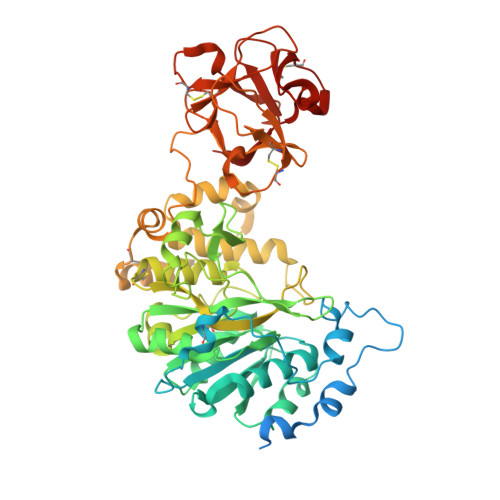The small molecule luteolin inhibits N-acetyl-alpha-galactosaminyltransferases and reduces mucin-type O-glycosylation of amyloid precursor protein.
Liu, F., Xu, K., Xu, Z., de Las Rivas, M., Wang, C., Li, X., Lu, J., Zhou, Y., Delso, I., Merino, P., Hurtado-Guerrero, R., Zhang, Y., Wu, F.(2017) J Biological Chem 292: 21304-21319
- PubMed: 29061849
- DOI: https://doi.org/10.1074/jbc.M117.814202
- Primary Citation of Related Structures:
5NDF - PubMed Abstract:
Mucin-type O -glycosylation is the most abundant type of O -glycosylation. It is initiated by the members of the polypeptide N -acetyl-¦Á-galactosaminyltransferase (ppGalNAc-T) family and closely associated with both physiological and pathological conditions, such as coronary artery disease or Alzheimer's disease. The lack of direct and selective inhibitors of ppGalNAc-Ts has largely impeded research progress in understanding the molecular events in mucin-type O -glycosylation. Here, we report that a small molecule, the plant flavonoid luteolin, selectively inhibits ppGalNAc-Ts in vitro and in cells. We found that luteolin inhibits ppGalNAc-T2 in a peptide/protein-competitive manner but not promiscuously ( e.g. via aggregation-based activity). X-ray structural analysis revealed that luteolin binds to the P X P motif-binding site found in most protein substrates, which was further validated by comparing the interactions of luteolin with wild-type enzyme and with mutants using 1 H NMR-based binding experiments. Functional studies disclosed that luteolin at least partially reduced production of ¦Â-amyloid protein by selectively inhibiting the activity of ppGalNAc-T isoforms. In conclusion, our study provides key structural and functional details on luteolin inhibiting ppGalNAc-T activity, opening up the way for further optimization of more potent and specific ppGalNAc-T inhibitors. Moreover, our findings may inform future investigations into site-specific O -GalNAc glycosylation and into the molecular mechanism of luteolin-mediated ppGalNAc-T inhibition.
Organizational Affiliation:
From the Key Laboratory of Systems Biomedicine (Ministry of Education) and Collaborative Innovation Center of Systems Biomedicine, Shanghai Center for Systems Biomedicine, Shanghai Jiao Tong University, 800 Dongchuan Road, Shanghai 200240, China.




















